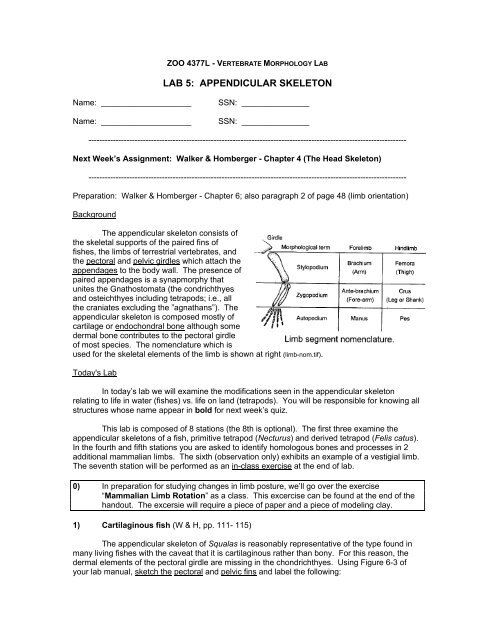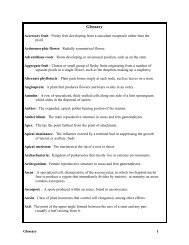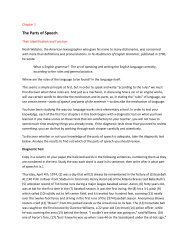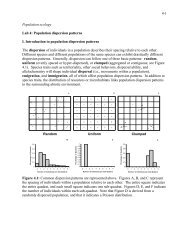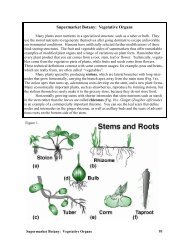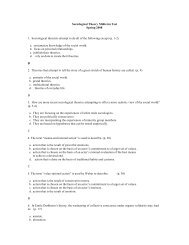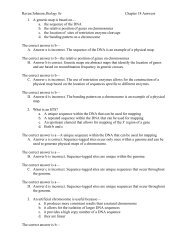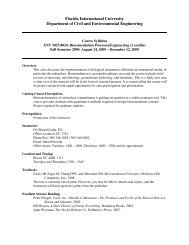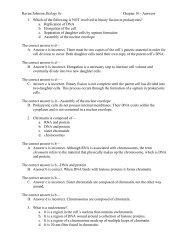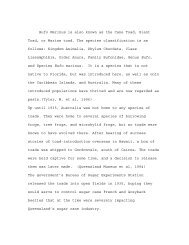LAB 5: APPENDICULAR SKELETON
LAB 5: APPENDICULAR SKELETON
LAB 5: APPENDICULAR SKELETON
Create successful ePaper yourself
Turn your PDF publications into a flip-book with our unique Google optimized e-Paper software.
ZOO 4377L - VERTEBRATE MORPHOLOGY <strong>LAB</strong><strong>LAB</strong> 5: <strong>APPENDICULAR</strong> <strong>SKELETON</strong>Name: ____________________Name: ____________________SSN: _______________SSN: _______________---------------------------------------------------------------------------------------------------------------------Next Week’s Assignment: Walker & Homberger - Chapter 4 (The Head Skeleton)---------------------------------------------------------------------------------------------------------------------Preparation: Walker & Homberger - Chapter 6; also paragraph 2 of page 48 (limb orientation)BackgroundThe appendicular skeleton consists ofthe skeletal supports of the paired fins offishes, the limbs of terrestrial vertebrates, andthe pectoral and pelvic girdles which attach theappendages to the body wall. The presence ofpaired appendages is a synapmorphy thatunites the Gnathostomata (the condrichthyesand osteichthyes including tetrapods; i.e., allthe craniates excluding the ”agnathans”). Theappendicular skeleton is composed mostly ofcartilage or endochondral bone although somedermal bone contributes to the pectoral girdleof most species. The nomenclature which isused for the skeletal elements of the limb is shown at right (limb-nom.tif).Today's LabIn today’s lab we will examine the modifications seen in the appendicular skeletonrelating to life in water (fishes) vs. life on land (tetrapods). You will be responsible for knowing allstructures whose name appear in bold for next week’s quiz.This lab is composed of 8 stations (the 8th is optional). The first three examine theappendicular skeletons of a fish, primitive tetrapod (Necturus) and derived tetrapod (Felis catus).In the fourth and fifth stations you are asked to identify homologous bones and processes in 2additional mammalian limbs. The sixth (observation only) exhibits an example of a vestigial limb.The seventh station will be performed as an in-class exercise at the end of lab.0) In preparation for studying changes in limb posture, we’ll go over the exercise“Mammalian Limb Rotation” as a class. This excercise can be found at the end of thehandout. The excersie will require a piece of paper and a piece of modeling clay.1) Cartilaginous fish (W & H, pp. 111- 115)The appendicular skeleton of Squalas is reasonably representative of the type found inmany living fishes with the caveat that it is cartilaginous rather than bony. For this reason, thedermal elements of the pectoral girdle are missing in the chondrichthyes. Using Figure 6-3 ofyour lab manual, sketch the pectoral and pelvic fins and label the following:
Identify:pectoral finsuprascapular cartilagescapulocoracoidglenoid fossa or surfacescapular processcoracoid barpterygiophoresbasalradialceratotrichiapelvic finpuboischiadic baracetabulumiliac processpterygiophoresbasalradialceratotrichia? What type of tissue (i.e., skeletal (cartilage) or soft?) appears to attach the suprascapularcartilage to the vertebral column?? What articular surface marks the border between the scapular process and coracoid bar?? How many basal pterygiophores are found in the pectoral fin? In the pelvic fin? Whatare their names? Which of these is thought to be homologous to the stylopod of thetetrapod limb? What is the basis for this hypothesised homology?? Look up the roots of the term pterygiophore (i.e., pterygio- + phore-) in Brown’sComposition of Scientific Words. What do they mean?? What articular surface is found on the puboischiadicbar? Look up the root of this term in Brown’sComposition of Scientific Words.? What sex is this skeleton? How can you tell? (Figurekm10-8)2) Primitive Tetrapod Condition (W & H, pp. 117 -118)
Amphibians and many living reptiles retain rather primitive features of both the pectoraland pelvic limbs. In this section we will determine how a transition to terrestrial life has reshapedthe pectoral and pelvic fins into pectoral and pelvic limbs by examining an amphibian, themudpuppy, Necturus machlosus. Among the amphibians, salamanders, like many living reptiles,retain rather primitive features in both their pectoral and pelvic limbs, and thus can be viewed asrepresenting the primitive tetrapod condition. While Necturus is secondarily aquatic as an adult,it’s ancestors were fully terrestrial as adults, and this is reflected in its terrestrial like appendages.The advantage of examining Necturus therefor lies in its large size, as most salamanders arevery much smaller. As was the case in the axial skeleton, the appendicular skeleton of the otheramphibians (frogs and caecilians) are highly derived.Examine the pectoral and pelvic limbs of the mudpuppy (Necturus machlosus)) skeletalmount. Using Figure 6-7 of your lab manual, sketch the fore- and hind-limbs and label thefollowing:Identify:forelimbpectoral girdlescapulaglenoid fossa[coracoid plate - cartilaginous; not preserved]]humerusradiusulnacarpalsmetacarpalsphalangeshindlimbpelvic girdleiliumacetabulumpuboischiadic plateischium[pubis - cartilaginous; not preserved]femurtibiafibulatarsalsmetatarsalsphalanges? Note that parts of the girdles and limbs in Necturus are only partially ossified (like ashark’s). What common enviromental feature do both dog sharks and Necturus share?What would be the advantage of leaving the cartilage unossified?For examples of pectoral and pelvic girdles in a primitive tetrapod that are completely ossified,examine those of the alligator (Alligator mississippiensis).? In what plane (see Figure N-1 on page xii) does the long axis of the brachium (=stylopod)? In what plane does the long axis of the antebrachium (= zygopod) lie? Notethat in such a sprawling posture, only one segment of the limb contributes to the
excursion of the limb (stride length) during locomotion, in this case the brachium (=stylopod) which moves from a protracted (flexed) to retracted (extended) position duringits stride. Also, note that the proximal articular surface of the brachium lies directly on theproximal end of the shaft.? In the antebrachium (=zygopod), which bone lies pre-axially (i.e. cranially)?? How many digits does the manus have? Given the ancestral condition is for five digits,which of the original five digits is believe to be lost in extant amphibians? What famouscartoon family has only four digits on their manus?? What is the phalangeal formula of the right manus (=autopod; the left is damaged andincomplete)?? In what plane (see Figure N-1 on page xii) does the long axis of the femur (thigh;=stylopod) lie? In what plane does the long axis of the shank (leg; = zygopod) lie? As inthe forelimb, only the proximal segment of the limb (the femur) contributes to theexcursion of the limb (stride length) during locomotion.? In the shank (leg; = zygopod), which bone is pre-axial (i.e., cranial)?? How many digits does the pes (=autopod) have? Given the ancestral condition is for fivedigits, which of the original five digits is believe to be lost in extant amphibians?? What is the phalangeal formula of the right pes (=autopod; the left is damaged andincomplete)? Is it the same as the manus?3) Derived Tetrapod Condition (W&H pp. 124-132)In both birds and mammals the limbs are oriented so that they lie beneath the bodyrather than extending from it, as is the case in fish and primitive tetrapods, giving theseorganisms an erect (rather than sprawling) posture. The functional consequences of this changein orientation will be addressed below.Examine the fore- and hind-limbs of the cat (Felis catus) skeletal mount. Work throughpages124 - 132 of your manual to identify the following bones and landmarks. Using Figure 5-5 sketchthe forelimb and hindlimb skeletons (including girdles) and label the following:forelimb“scapula”coracoid process (homolog of posterior coracoid)scapular spine (spinous process )acromionmetacromionglenoid fossaclavicle
humerusheadtrochleacapitulumulnaolecranon [process]radiusheadcarpalspisiformmetacarpalsphalangeshindlimbos coxailiumischiumpubisacetabulumobturator foramenfemurheadpatellatibiafibulatarsalstalus (astragulus)calcaneusmetatarsalsphalangesN. B. Before answering the following questions, you should probably work through the“Mammalian Limb Rotation” worksheet attached at the end of this handout, if you havenot already done so.? In both the pectoral and pelvic girdles of mammals and birds, many of the individual bonyelements have fused together (e.g., in mammals the os coxa results from the fusion ofthe ilium, ischium and pubis and the “scapula” from the scapula (proper) and (posterior)coracoid. What might the advantage of fusion be? What is the consequence of suchfusion in terms of growth?? Does the scapula have a direct attachment (i.e., articulation) to the axial skeleton? If not,what attaches the scapula to the axial skeleton? [Hint: See Figure 7-24.]? In what plane does the long axis of the brachium (stylopod) lie? In what plane does thelong axis of the antebranchium (zygopod) lie? How does this arrangement differ fromNecturus? Note that in such a posture, both the stylopod and zygopod (and possibly theautopod, if the organism is digitigrade; see below) now contribute to stride length.Finally, note that the proximal articular surface of the brachium (and femur) is offsetmedially.
? In front of you is a pseudo-fossil representing the stylopod of a fossil tetrapods.Examining its proximal end, what can you deduce about the posture of this organism?Why?? Examine the skeletal elements of the antebrachium (zygopod). At the proximal end,which bone is lateral-most? Distally, which bone is lateral-most? Why do the bones ofthe antebrachium cross?? How many digits are there on the manus (autopod) ? What is the phalangeal formula?? Of the 7 named carpal bones, which is a sesamoid bone?? What skeletal elements of the manus contact the substrate? For this reason, cats aresaid to have digitigrade posture. If the entire autopod contacted the ground they wouldbe plantigrade.? Which bone of the os coxa articulates with the sacrum?? In what plane does the long axis of the thigh (femur; =stylopod) lie? In what plane doesthe long axis of the shank (leg; = zygopod) lie? How does this arrangement differ fromNecturus?? In the shank (leg), do the 2 skeletal elements cross? Why not? Which is lateral andwhich is medial?? Which of the shank (leg; = zygopod) bones articulates with the femur? What other bonearticulates with distal condyles of the femur?? Which of the tarsals forms the talo-crual (“ankle:) joint? Which of the tarsals forms theheel? What is the root of the latter term (see Brown’s Composition of Scientific Words)?? How many digits are there on the pes (= autopod)? What is the phalangeal formula?---------------------------------------------------------------------------------------------------------------------4) Horse (Equus caballus) limb? First, before reading any further, is this a forelimb or a hindlimb? Explain your choice:Based on your superb knowledge of cat skeletal anatomy and your razor-sharp prowessin establishing homologies, be prepared to identify the following structures:scapula
coracoid process (homolog of posterior coracoid)scapular spine (spinous process )glenoid fossahumerusheadtrochleacapitulumolecranon fossaulnatrochlea notcholecranon [process]radiusheadcarpalspisiformmetacarpalsphalanges? Is there an acromion in the horse?? What is different about the articulation between the radius and humerus in the horse asopposed to the cat? [Hint: In the cat, the radius articulates with what part of the distalhumerus? What parts of the distal humerus does the horse radius articulate with?] Whymight this be?? Compared to the cat, what is the relative mobility between the radius and ulna in thehorse?? How many metacarpals are present? How many digits? What is the phalangeal formulaof the manus?---------------------------------------------------------------------------------------------------------------------
5) Human fore- and hind-limbsBased on your superb knowledge of cat skeletal anatomy and your razor-sharp prowessin establishing homologies, be prepared to identify the structures listed for the cat in section 3above.? Can you find a metacromion on the human scapula? This is a muscular process (i.e., abony projections that serves as an attachment site for a muscle). Speculate as to thehuman condition in terms of presence or relative size of the cat muscle that attaches tothe metacromion.? In all quadrupedal mammals the pisiform is enlarged and posteriorly projecting (see catand horse). It lies within the tendon of the flexor carpi ulnaris muscle which is a majorflexor of the wrist joint. Hypertrophy of the pisiforms increases the moment arm of themuscle and hence its rotational force (torque) output. Look at the pisiform in the humanhand. Why isn’t it hypertrophied?6) Whale hindlimb (observation only)In cetaceans the pectoral limb has been modified intoa flipper (see overlay) which acts as a hydrofoil. The clavicleis absent. Except for the glenohumeral (“shoulder”) joint, allarticulations are fibrous and virtually immovable. The radius,ulna and digital elements are greatly flattened and thephalanges of the second and third digits always exceed thenormal number (hyperphalangism). The pelvic limb is greatlyreduced and has lost contact with the vertebral column. In allwhales a vestigial os coxa is found. Among the toothedwhales (Odontoceti) a vestige of the femur is present only inthe sperm whale. Among the baleen whales (Mysticeti) avestigial femur is present, and in some species a vestigialproximal tibia is retained. The cetacean os coxa is extremelyvariable in form (see figure) and is always larger in males, notinfrequently being absent in females. The size difference isdue to the larger perineal muscles (associated with the penis)found in males. The identify of the bony elements (ilium,ischium and/or pubis) that contribute to the cetacean os coxa is disputed.On display is the left ox coxa from a male beaked whale (Mesoplodon europaeus) whichbeached on Stock Island, FL in October of 1998. The whale was 4.2 meters in length andweighed approximately 390-550 kg. Compare its size to that of your own os coxa. How long areyou and how much do you weigh? Do you think that this is a vestigial organ?
7) In-class excercise: Advantages (and costs) of an erect postureYou may wish to ask your instructor forassistance in this section. Let’s comparetwo organisms, one with a sprawlingposture (e.g., Necturus) and one with anerect limb posture (e.g., Felis; Figure 2K9-32). We will make the followingassumptions:1) both organisms are of equalmass2) both organisms have equal limblengths (distance fromproximal stylopod to distalautopod)3) all limbs segments are of equal length (stylopod = zygopod = autopod)4) both organisms have equal stride frequencies (see below)4) in both organisms the center of mass lies at the point midway between the acetabulumand glenoid fossaAn advantage of erect posture: Recall that in pedal locomotionvelocity = stride length ∗ stride frequency? How many limb segments contribute to stride length in the organism with sprawling posture?? How many limb segments contribute to stride length in the organism with erect posture?? Recall that stride frequency is assumed to be equal between the two organisms, which will befaster (achieve a higher velocity)? Why?? Among organisms with erect posture, assuming equal total limb lengths and equal stridefrequencies, which will be faster, digitigrade or plantigrade organisms? Why?A cost of erect posture. Recall that:force = mass * accelerationObjects falling unimpeded under the influence of gravity have an acceleration (g) = 9.8m/s 2 withgravity acting about the center of mass.? How many limb segments contribute to elevating the center of mass in the organism withsprawling posture?? How many limb segments contribute to elevating the center of mass in the organism witherect posture?Remembering that the organisms are of equal mass, which organism, sprawling or erect, willachieve a greater force in falling from a standing position? Why? [Hint: Think aboutthe relative heights of the center of mass.]
? Under the constraints of this model, can one simultaneously increase stride length anddecrease the height of the center of mass? If the requirement of equal limbsegments is relaxed, how can you increase stride length in the sprawling posturewithout increasing the center of mass? What might constrain (limit) this “adaptation.”--------------------------------------------------------------------------------8) Human pelvic girdle sexual dimorphism (optional)Like the shark, the pelvic girdle of humans is sexually dimorphic, although for differentfunctions. Use the handout and workbook to determine the gender of the two os coxae ondisplay.


